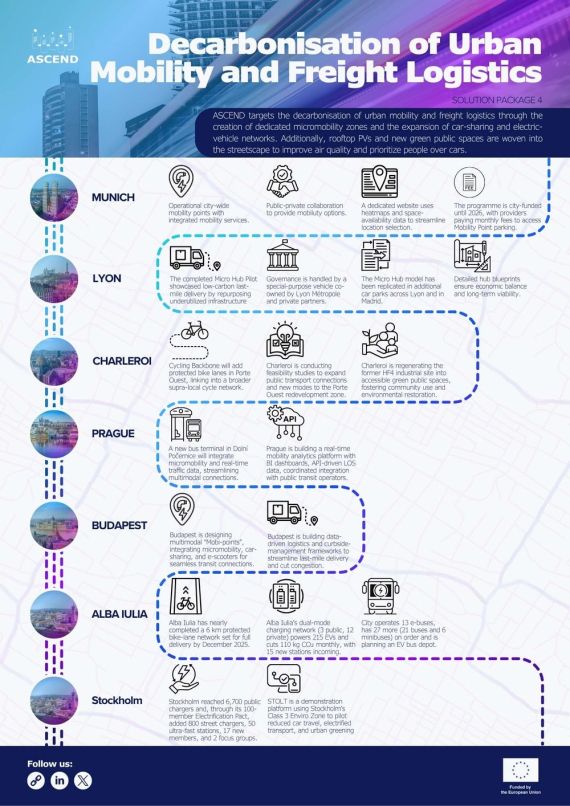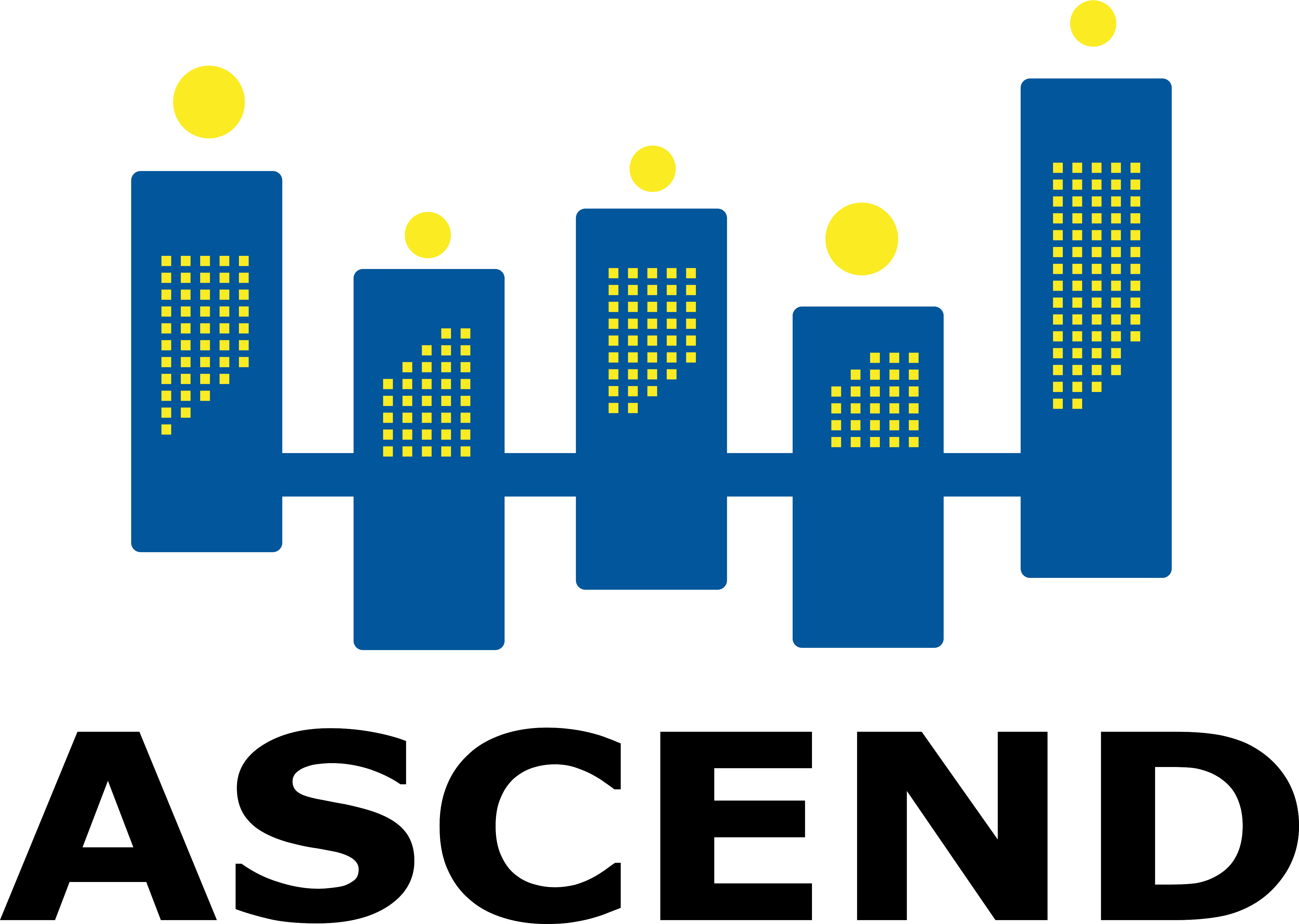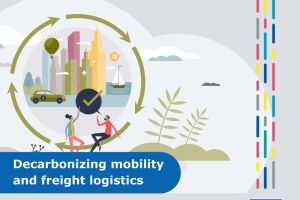
With Solution Package 4, ASCEND’s goal is to decarbonise mobility and freight logistics. This will be achieved with the creation of public spaces for micro-mobilities, the promotion of carsharing and electromobility, using PV energy from buildings to power vehicles of logistic providers, and creating new green public spaces.
- Public spaces for micromobilities
- Promotion of car-sharing and electromobility for passenger travels
- Decarbonisation of freight logistics
- Shared public spaces with ‘Nature’

Decarbonisation of Urban Mobility and Freight Logistics
ASCEND targets the decarbonisation of urban mobility and freight logistics through the creation of dedicated micromobility zones and the expansion of car-sharing and electric vehicle networks. Additionally, rooftop PVs and new green public spaces are woven into the streetscape to improve air quality and prioritize people over cars.
Alba Iulia’s Sustainable Mobility Push: Progress on SP4 – Decarbonisation of Mobility and Freight Logistics through Frugal and Scalable Solutions
Alba Iulia is advancing its urban decarbonisation efforts through two complementary initiatives: the expansion of protected cycling infrastructure within the PCED and the deployment of electric vehicle (EV) charging stations across the city. These efforts support a modal shift from fossil-fuel-based transport to cleaner, low-emission alternatives, aligned with the city’s broader sustainable mobility goals.
Key Developments in Alba Iulia’s SP4 Solutions
1. Protected Bike Lane Network
- As part of a broader urban mobility strategy, the city implemented a 6 km network of protected bike lanes, with 3 km completed within the PCED.
- The lanes are constructed on the sidewalks of major avenues, ensuring visibility and safety for cyclists.
- The infrastructure works are 90% complete, with final reception underway. A deadline extension to December 2025 was granted to accommodate delays caused by project complexity. The bike lanes are already operational in parts of the district, contributing to early emissions reductions and public visibility.
- Only e-bike sharing system remains to become operational
Source: Municipality of Alba Iulia
2. Electric Vehicle Charging Infrastructure
- The chargers feature dual-mode (AC/DC) for both fast and slow charging, helping meet diverse user needs.
- The city currently hosts 215 electric vehicles (2024 data) and over twice as many hybrids. It is estimated that current usage avoids approximately 9,000 kWh/month of energy and 110 kg of CO₂ emissions.
- Alba Iulia will install 15 new e-car charging stations through the National Recovery and Resilience Plan, targeting both the general public and municipal fleet.
- Existing infrastructure includes 3 city-operated and 12 privately operated stations. The new stations will be installed by contractors selected through public procurement.
- The city uses third-party platforms (e.g. www.evconnect.ro) for station availability, management, and reporting.
3. Electric busses:
- 13 Electric busses acquired and currently in function
- 27 other busses + micro-buses underway through the NRRP (21 buses and 6 minibuses)
- One EV bus depot currently under submission under the National Resilience and Recovery Plan (NRRP)
Business Model & Funding
- The e-charging infrastructure is funded via the Environment Fund Agency, ROP, and National Recovery and Resilience Plan, totaling around €600,000 and will be implemented until the beginning of 2027.
- While the electricity is sold at no margin by certified providers, the city does not generate direct revenue from the stations.
- Contractors are responsible for operations, maintenance, and customer service, selected through a public acquisition process.
Challenges and Risks
- Low adoption of cycling among older residents, often due to digital literacy barriers.
- System maintenance challenges and risk of infrastructure damage.
- Risk of delayed ERDF funding if final works are not completed by the 2025 deadline.
- Electricity grid connections and space constraints for EV chargers may limit technical rollout.
- Need for promotion and behavioral change to increase use of both systems.
Next Steps
- Finalize the bike lane infrastructure with complete official reception of e-bike sharing by end of 2025.
- Launch a communication campaign in 2025 to encourage active mobility and raise awareness.
- Begin deployment of the 15 e-car charging stations.
- Explore integration of PV systems and local energy storage for future infrastructure upgrades.
- Begin deployment of the next 21 buses and 6 microbuses.
- valorization of green energy produced within the municipality’s PV park on the belt road and also on the future PV park to be built in Oarda neighbourhood in the next period.
Lessons Learned
- Flexible timelines are necessary to manage complex infrastructure deployment and regulatory procedures.
- Public engagement is crucial to ensuring uptake, especially among less tech-savvy users.
- Digital inclusion should be integrated into planning to increase access.
- EV infrastructure is highly scalable, but success relies on strong coordination with grid operators and trusted contractors.
- Opportunities exist for further innovation in user apps, billing systems, and integration with local prosumer energy models.
Through these parallel efforts, Alba Iulia is actively decarbonising its transport systems and laying the groundwork for a cleaner, more resilient urban mobility landscape within its PCED area and at wider city level area.
Budapest is taking bold steps to decarbonise urban transport through a coordinated package of SP4 solutions, spanning shared mobility, urban logistics, school road safety, and public transport enhancements. These initiatives aim to shift behaviour toward greener modes while improving accessibility and efficiency across the PCED.
Key Developments in Budapest’s SP4 Solutions
Multimodal Mobility Points – Planning for Shared and E-Mobility Integration
Budapest is planning a network of mobility points that combine micromobility, shared car services, and e-scooters in strategically located hubs. The concept supports seamless intermodality between public transport and new mobility services.
- Micromobility points (MOBI-points) have been fully planned for the southern area adjacent to the PCED.
- Within the PCED, planning is ongoing, including the Megyeri Street – Fóti Street junction as part of the REALLOCATE project.
- Future upgrades may include expansion into e-mobility points.
Urban Logistics & Curbside Management – Data-Driven Freight Efficiency
To improve freight logistics, Budapest is developing a city logistics methodology and a curbside management framework. These tools aim to optimize last-mile delivery, reduce congestion, and better allocate public space.
- The city logistics methodology and the curbside management framework have been completed. Based on them, curbside related pilot interventions are under preparation in different part of the city.
- Logistics operators, local businesses, and residents are being consulted.
Safer School Streets – Traffic Calming and Public Awareness
Budapest is implementing traffic calming measures around schools to improve child safety and encourage walking and cycling.
- The planning and implementation are completed. K+R parking space has been designated near the school.
- “School zone” signs, painted pavements, and physical street elements (e.g. flower boxes) are planned to reduce vehicle speeds.
- Inspired by international good practices, including Barcelona’s school streets programme.
Public Transport Expansion – Enhanced Connectivity in District IV
As of August 2024, new and improved bus services are operating in the PCED area. Adjustments were made based on public consultation and in collaboration with District IV authorities.
- Planning and implementation are complete.
- The service is now operational and undergoing evaluation.
Next Steps
- Finalise the planning and stakeholder engagement for (micro)mobility points.
- Apply the curbside management framework within the PCED.
- Install traffic calming infrastructure around local schools.
- Monitor the performance of new public transport services.
Lessons Learned
- Data and Coordination: Effective logistics solutions require robust data and multi-actor coordination.
School Streets: Tailored traffic interventions can improve child safety with low-cost, high-impact measures. - Integrated Mobility Planning: Combining micromobility, logistics, and public transport improvements reinforces sustainable behaviour change.
Budapest’s integrated SP4 strategy demonstrates how cities can simultaneously enhance mobility, reduce emissions, and improve public space by leveraging frugal, flexible solutions tailored to local contexts.
Charleroi is reshaping its urban environment through a multi-pronged SP4 strategy that links bike infrastructure, green public space, and expanded transport connections. The aim is to support a sustainable urban transition by anchoring low-carbon mobility within long-term spatial planning and community well-being.
Key Developments in Charleroi’s SP4 Solutions
Cycling Backbone – Connecting Urban Routes Through New Bike Lanes
Charleroi is developing protected cycling infrastructure within the Porte Ouest territory. These routes will be part of a larger-scale urban redevelopment strategy and will contribute strengthening the network of supra-local functional cycle routes
- First secured financing sources through the European Regional Development Fund.
- First technical specifications are being prepared.
- Further studies for developing other sections of the supra-local network.
Public Transport Expansion – Scenario Planning and Feasibility Studies Underway
To ensure sustainable access to the Porte Ouest redevelopment zone, Charleroi is assessing how to connect the area to the broader transit system through new modes and network links.
- A dedicated mobility working group was created to guide developments.
- Road infrastructure planning scenarios are ongoing to align with future developments.
- Potential water-based alternatives are also under review for goods transport (hub logistics).
Green Space Activation – Regeneration of HF4 Industrial Site
Charleroi is enhancing and creating green public spaces to promote accessibility, community use, and environmental regeneration. A particular focus is on the HF4 industrial site.
- A patrimony working group was established to oversee heritage-led urban regeneration.
- 3 main functions are targeted: Industrial heritage, Urban culture events. Park as symbol of resilience between past and future.
Next Steps
- Finalise technical specifications for funded bike sections.
- Engage stakeholders in public transport planning.
- Spatial programming for the HF4 industrial site.
Lessons Learned
- Integrated Planning Is Essential: Cross-sector coordination among mobility, heritage, and environmental actors is vital for coherent and sustainable development.
- Funding Flexibility Is Key: Rejection of initial funding has spurred new strategies to diversify support sources for long-term regeneration.
- Greening as a Driver for Engagement: The enhancement of public space supports active mobility while making the city more attractive and liveable.
Charleroi’s SP4 work reflects a commitment to sustainable mobility and placemaking by weaving together infrastructure, ecology, and culture in a cohesive urban strategy.
In recent years, Lyon tested a low-carbon urban logistics solution through the Micro Hub pilot in the underground car park of Parc Marché Gare. This initiative, part of the LEAD H2020 project, enabled last-mile delivery using low-emission vehicles and helped explore innovative public-private partnerships. While the original Micro Hub has since been returned to conventional parking use, similar adaptations have been replicated in other parts of the city.
In the Positive Clean Energy District, the major ongoing SP4 solution is the development of a new Mobility Hub that will integrate low-carbon transport services and infrastructure to support climate-friendly mobility.
Key Developments in Lyon’s SP4 Solutions:
- Micro Hub Pilot (completed): Enabled low-carbon last-mile delivery and demonstrated how underused infrastructure can be repurposed for sustainable logistics.
- Governance Innovation: Managed by a special-purpose vehicle co-owned by Lyon Metropolis and private partners, offering lessons for future mobility solutions.
- Replication: Elements of the Micro Hub model were transferred to other car parks across Lyon and in Madrid.
Current Progress in the PCED Area:
- Mobility Hub Planning: Studies on mobility service needs are nearly complete.
- Economic Modelling: Several business models have been assessed with R2M, leading to a financial agreement between SPL Lyon Confluence and the property developer.
- Design Phase: Hub blueprints have been drawn up, ensuring economic balance and long-term viability.
Next Steps:
- Begin construction in early 2026.
- Select carbon-free mobility operators.
- Install key infrastructure, including electric charging stations.
Lessons Learned:
- Efficient Use of Space: Temporary repurposing of existing infrastructure can provide a cost-effective pathway to test logistics innovations.
- Scalable Models Require Flexibility: Urban replication is feasible when space and permitting processes align.
- Public-Private Collaboration is Key: Successful projects depend on aligning governance and operational models between cities and logistics stakeholders.
Lyon’s journey from logistics pilot to long-term infrastructure planning shows how adaptive urban mobility strategies can pave the way for decarbonising transport while supporting broader Positive Clean Energy District goals.
Munich is advancing sustainable mobility through its large-scale Mobility Point initiative—a citywide network offering bundled shared mobility services as convenient alternatives to private car use. Led by the City of Munich and co-developed with citizens and private providers, this approach supports the city’s goal to achieve climate neutrality by 2035 by reducing fossil fuel consumption and improving access to sustainable transport.
Key Developments in Munich’s SP4 Solutions
- Citywide Mobility Points – By 2026, 200 locations will offer integrated mobility services, including carsharing, bike and e-scooter sharing, cargo bikes, and repair stations. 102 points are already operational.
- Public-Private Collaboration – The city provides infrastructure such as parking, signage, and markings, while private companies supply and manage the vehicles.
- Strategic Mobility Planning – Mobility Points serve as a sustainable extension to public transport, improving accessibility and reducing CO₂ emissions, noise pollution, and car dependency.
- Digital Tools & Data Use – A dedicated website support easy access. Location selection is based on heatmaps and space availability data.
- Participatory Governance – Citizens and local district committees could suggest Mobility Point locations via the participatory platform Unser München. In cases of doubt, they should provide good arguments for the choice of location by the city administration.
- Funding & Procurement – The programme is city-funded until 2026, with providers paying monthly fees to access Mobility Point parking. Post-2026, an impact assessment will guide future funding strategies.
Next Steps
- Expand the network to reach the target of 200 locations by 2026.
- Evaluate the environmental and behavioural impacts of the Mobility Points to inform long-term planning.
Lessons Learned
- Rapid Deployment & Scalability – The solution is low-cost and fast to implement, making it highly replicable in other cities.
- Flexibility & Inclusivity – Multiple transport modes in a single location offer convenience and promote mobility equity.
- Behavioural Impact – The model is proven to reduce private car ownership when implemented citywide.
- Multi-Stakeholder Innovation – Co-designing the system with citizens and providers enhances uptake and long-term impact but slows down the process and is often impossible to realise.
Already being replicated in other German cities such as Bremen, Nürnberg, Erlangen, Kempten, and Rostock, Munich’s Mobility Points demonstrate how bundling shared services in public space can accelerate the transition to climate-friendly urban transport systems.
Mobility points – situation in Harthof
Two Mobility points got installed in early spring 2025 at two locations in Harthof including free floating carsharing, and shared mobility vehicles like E-scooters, Bikes and E-Mopeds. Further equipment is foreseen for 2026.
Stockholm is advancing its sustainable mobility agenda through a combination of citywide electrification initiatives and area-based demonstrations. The strategy focuses on reducing emissions from transport while improving accessibility, infrastructure quality, and the urban environment. Central to this effort are two interlinked actions: the Electrification Pact and the STOLT demonstrator platform.
Key Developments in Stockholm’s SP4 Solutions
Electrification Pact – Scaling charging infrastructure and public-private collaboration
Stockholm has rapidly increased its charging capacity, now offering approximately 6,700 public charging points, including 1,700 located on city streets. The city has also expanded its collaborative platform, the Electrification Pact, a public-private network that currently includes nearly 100 members from the energy, automotive, and logistics sectors.
In 2024, the Pact:
• Installed approximately 800 new street-level charging points
• Launched over 50 public ultra-fast chargers, including infrastructure for electric taxis in the planned Class 3 Environmental Zone
• Welcomed 17 new members and initiated two focus groups to drive sector-specific actions
• Conducted large-scale and small-group network meetings and public campaigns
A renewed direction was announced at Stockholm City Hall in early 2025, with leadership from the Acting Mayor of Finance and Mayor of Traffic, alongside CEOs from Scania, Ellevio, and Volkswagen. The updated focus includes:
• Developing appropriate charging infrastructure and grid capacity
• Implementing regulation to support accelerated transition
• Promoting zero-emission vehicle deployment and services
Ellevio, a key stakeholder, has committed over SEK 10 billion to date and plans to invest an additional SEK 19 billion in Stockholm’s electricity grid by 2030. The company also aims to fully electrify its own and subcontractors’ vehicles and work machinery.
STOLT (Stockholm Local Transitions) – System demonstrator for emission-free inner city
STOLT functions as both a demonstration and transition platform to support the goal of a fossil-free inner city by 2030. It builds on the introduction of a Class 3 Environmental Zone in the Old Town to pilot strategies that reduce car travel, electrify urban transport, and enhance the urban environment.
The project consists of coordinated demonstrations that target:
- Reduction in car traffic
- Electrification of fleets and services
- Improvement of public space quality
Through STOLT, Stockholm is also developing internal capabilities in system innovation, collaborative governance, digital transformation, and adaptive learning.
Lessons Learned
- Integrated Action Platforms Foster Acceleration: Stockholm’s networked approach through the Electrification Pact shows how collaboration across sectors supports rapid infrastructure rollout and shared commitments.
- Area-Based Demonstration Supports System Innovation: STOLT’s targeted implementation demonstrates how emissions reduction, urban livability, and capacity-building can be advanced together.
- Grid Investments Are Critical Enablers: Large-scale electrification requires smart grid development to accommodate increased demand and ensure long-term system resilience.
- Stockholm’s SP4 strategy combines large-scale infrastructure deployment with localised innovation, offering a replicable framework for urban mobility decarbonisation aligned with the city’s climate neutrality goals.

